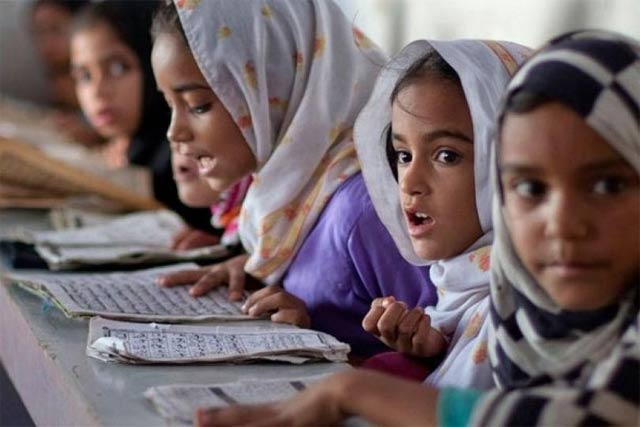
Why? Because the official curriculum is a deliberate tool of the Pakistani state’s nation-building project; because religious parties throw a fit every time there is some progress, as they did recently in Khyber-Pakhtunkhwa (K-P); and because rewriting textbooks from scratch is hard. But what if excellent alternative textbooks already existed, and the only thing we needed was a translation?
Malala gets straight 'A's in O'Level exams, makes Pakistan proud once again
Those excellent texts are the ‘O’ levels Pakistan Studies textbooks — the required one written by Nigel Kelly, and a secondary one by Farooq Naseem Bajwa. I recently reviewed these, and my latest research paper compares these books with the Matric textbooks in detail. There are big differences between the two sets of books — probably not a surprise to many. I list some of them here.
First, the Pakistan ideology, that central premise and starting point of the Matric textbooks — that the sole basis of Pakistan is Islam — is nowhere to be found in the ‘O’ levels books. This ideology was not born with Pakistan, but was a concept constructed by the Jamaat-e-Islami and introduced into textbooks in the 1970s and early 1980s via a University Grants Commission directive.
Record number of O and A level exams sent to be regraded
Two, the evolving historical and political story of Partition is told in the ‘O’ levels books rather than the linear narrative presented in the Matric books. The Cambridge texts describe periods of Hindu-Muslim cooperation. Kelly mentions Sir Syed Ahmed Khan’s initial pronouncements about Hindus and Muslims being one nation, and also mentions Jinnah’s initial opposition to Partition before explaining how events changed their minds.
Third, the ‘O’ levels book shows the positive side of India and Hindus (along with the negatives). Upon Partition, when India withheld the cash it owed Pakistan, “Gandhi was determined that the division of assets should be as fair as possible. He objected to what the Indian government was doing”. The book states that Gandhi began a hunger strike, and as a result, the Indian government paid Pakistan the remaining Rs500 million it owed us.
Pride of the nation: Matric, intermediate toppers felicitated at ‘historic’ event
Fourth, the ‘O’ levels books quote Jinnah’s critical statement: “You may belong to any religion, caste or creed — that has nothing to do with the business of the state.” They also mention his title of “protector-general” of minorities. It is then no surprise that Dr Tariq Rahman found in his 2002-03 survey that ‘O’ levels students have more tolerant views of minorities relative to Matric students — with 66 per cent of ‘O’ levels students versus 47 per cent of Matric students supporting equal rights for Ahmadis, 78 per cent versus 47 per cent for Hindus, and 84 per cent versus 66 per cent for Christians.
One criticism of Kelly’s book, and the official ‘O’ levels curriculum, is that it could cover a longer historical period. Currently, it covers the history of the subcontinent from the Mughal Empire onwards. Bajwa’s book casts the widest lens on pre-independence history, (briefly) covering Hindu empires, the Indus Valley civilisation, and the Persian and Greek invaders of the subcontinent.
High achievers: 70 per cent pass matric examinations in Lahore
But the pluses of the ‘O’ levels books are not confined to content: the style and methods are equally important. The Matric books present no sources, primary or secondary. There is no sense of historical research, of historians’ and governments’ motivations in representing history one way or the other. But the Cambridge Pakistan Studies curriculum aims to “develop (an) understanding of the nature and use of historical evidence”, and the authors present an abundance of it in the textbooks — old speeches, the writings of prominent figures, historians’ accounts. Kelly reports how the same historical event is represented differently by different sides in the story — how 1857 was the “Indian mutiny” for British historians, but the “war of independence” for Indian historians. Questions are repeatedly posed to the reader — how, what, why — and these do not necessarily have one right or wrong answer. Students are asked to reconcile different accounts of the same event, and to draw their own conclusions.
Why is it that we treat one set of students — the elite ‘O’ levels students — as intelligent, but do not treat the vast majority of the country’s students the same way? Why must the Matric students be relegated to learn at a level many rungs down the ladder, and probably many levels below their abilities? It is morally unconscionable that two sections of our student population live and learn in the words of Dr Rahman as “denizens of alien worlds”.
Sindh govt to include Jinnah's August 11 speech in curriculum
There are legitimate concerns about how feasible it would be to teach a challenging ‘O’ levels curriculum in Pakistani government schools, with underpaid, undertrained and poorly motivated teachers to Matric students who have never been challenged to think for themselves, and with class sizes that make discussions difficult. But the books can be simplified, at least for a transition period, and made accessible to a Matric audience. Chances are that Matric students will adapt quickly to the challenging curriculum. Teachers will need to be trained extensively and critical thinking introduced early on in the system.
There is also a political barrier to surpass, with nay-saying religious parties. We need a strong government to push such a reform. But it is the way forward. The answer to our dual education systems lies not in moving to the local Matric system for all, but moving students up to the better system, one that helps create more intelligent, thoughtful and tolerant students.
Published in The Express Tribune, February 3rd, 2016.
Like Opinion & Editorial on Facebook, follow @ETOpEd on Twitter to receive all updates on all our daily pieces.



1716998435-0/Ryan-Reynolds-Hugh-Jackman-(3)1716998435-0-165x106.webp)



1729685382-0/Untitled-design-(57)1729685382-0-270x192.webp)


1730706072-0/Copy-of-Untitled-(2)1730706072-0-270x192.webp)
COMMENTS (21)
Comments are moderated and generally will be posted if they are on-topic and not abusive.
For more information, please see our Comments FAQ